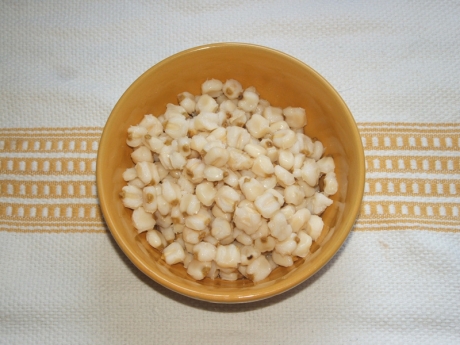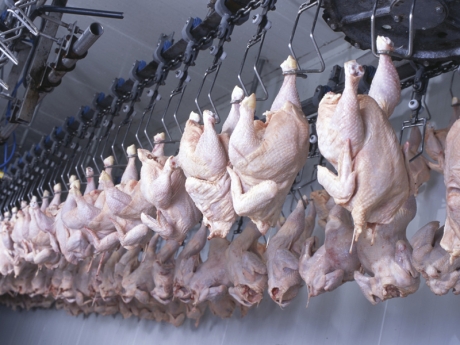Food Processing
Background
Food processing has come to be associated with ramen noodles, canned meat, and spongy snack cakes. The health concerns raised by these products have led many to assume that all processed foods are unhealthy, but do they deserve their reputation?
Businesses use food processing techniques to transform raw foods and ingredients into new products. These techniques run the gamut and include milling grains into flour, crushing seeds to extract their oil, churning milk into butter, mixing ingredients to make batter, and baking cookies on an assembly line. Meat processing, meanwhile, can involve techniques like cutting, deboning, and removing guts from carcasses.
While some food processing techniques use cutting-edge technology, others have been practiced for millennia. Thousands of years before food scientists figured out how to make dinosaur-shaped chicken nuggets, early Egyptians were brewing beer and baking leavened bread.1
Today, for better and for worse, nearly all our food is processed in some way. Food processing offers important benefits to businesses and consumers, including a more varied food supply and foods with a longer shelf life. Certain aspects of food processing, however, raise concerns over dietary health, worker health, and food safety.
Preservation and Food Safety

After fruits and vegetables are harvested, they begin to lose nutrients. Freezing, canning, or storing fresh produce under proper conditions can slow nutrient losses. While canned foods are often perceived as less nutritious than fresh or frozen ones, studies show this is not always the case. It depends on the type of produce, how long it had been stored, and how it will be prepared.6
Photo credit: Bernal Saborio. Creative Commons CC BY-SA 2.0.
Over time, yeasts, molds, bacteria, and other forces cause food to spoil, making it foul-tasting, less nutritious, and potentially unsafe to eat. Many of the oldest food processing techniques, such as drying fruit, pickling vegetables, salting meat, and fermenting dairy (e.g., to make cheese or yogurt) remain important to this day because they preserve food, delaying spoilage.2 Preservation allows people to ship foods over greater distances, stock them in stores longer, and enjoy them for a greater part of the year with more nutrients intact.
Processing can also help to inhibit or destroy pathogens (disease-causing organisms) that may contaminate food. Preservation techniques such as refrigeration, fermentation, dehydration, and the use of salt, sugar, or chemical preservatives can slow or stop the growth of pathogens. Heat processes, such as pasteurization and cooking, are used to destroy them.1
Although businesses use food processing techniques to reduce food safety risks, the facilities where foods are processed are sometimes part of the problem. Large processing plants, for example, often handle large volumes of products from many different sources. If a shipment of spinach from one farm is contaminated with E. coli (as in the 2006 outbreak linked to bagged spinach3) and gets mixed together with greens from other farms, the entire batch may become contaminated before it is nationally distributed. As author Michael Pollan writes, “In effect, we’re washing the whole nation’s salad in one big sink.”4 Similarly, an entire shipment of ground beef or poultry can be tainted by a single contaminated carcass at a meat processing plant.
Variety and Convenience

Nattō, known for its pungent odor, is a Japanese dish made from fermented soybeans.
Fermentation transforms food through the action of yeasts and bacteria. This process has been harnessed by humans for millennia to make traditional foods and beverages such as wine, kombucha, sauerkraut, and yogurt. In addition to producing a variety of flavors and textures, fermentation can promote gut health, preserve foods, improve nutritional quality, and reduce cooking times.17,18
Photo credit: JD Kinchan1, 2011. Flickr. Creative Commons CC BY-SA 2.0.
By modifying the flavors, textures, aromas, colors, and form of foods and raw ingredients, food processing can create greater variety in our food supply.6,7 A trip down the breakfast aisle of a supermarket reveals the tremendous variety of products derived from just a few different types of grain. Every year, roughly 20,000 new processed food products are introduced on retail shelves.8 Of these, only the most successful remain.9
Processing can also create products that require little or no preparation on the part of consumers. Among the earliest processed “convenience foods” was pemmican—strips of dried buffalo meat mixed with fat and berries that could be eaten “on the go” by First Nations peoples of the Great Plains.10 Today, fast food, canned food, baby food, frozen entrées, packaged snack foods, and bottled beverages offer ready-to-heat or ready-to-eat convenience for busy eaters (and parents).10,11 From 1966 to 1999, the amount of time U.S. adults ages 25 to 54 spent cooking meals decreased by 25 percent. Among U.S. women, the amount decreased by 43 percent.12 Compared to the 1970s, Americans are consuming fewer calories at home and more at full-service and fast food restaurants,13 and an estimated 30 percent of U.S. children now eat at a fast food restaurant daily.14 These trends suggest a growing demand for convenience.
While fast food items and convenience foods are not universally unhealthy, many are made with refined grains, are high in added sugars and unhealthy fats, and have low nutritional value. Convenience foods may also encourage unhealthy eating patterns, such as skipping meals and overeating.15
Nutrition

Hominy, or nixtamalized maize.
Many traditional food processing techniques increase the availability of nutrients. Early Central American peoples, for example, prepared corn by soaking and cooking it in wood ashes. The process, called nixtamalization, made corn easier to grind and increased the availability of niacin, a B vitamin. When corn was later adopted as a staple crop among Europeans, they neglected to nixtamalize it, resulting in widespread niacin deficiency.
Photo credit: Geoff Lane, 2008. Creative Commons CC BY-SA 3.0.
Contrary to popular belief, the effects of food processing on nutrition are so varied that they cannot be generalized as unhealthy.
Some processing techniques deplete nutrients from food. Refining grains, for example, removes the bran and germ, which contain important nutrients like B vitamins, iron, and fiber.18 Other processing techniques, such as fermentation, can enhance the nutritional quality of food,17,19 while freezing fruits and vegetables can preserve nutrients after they are harvested.5
Some processing techniques raise nutrient levels by adding vitamins and minerals. Enrichment is the restoration of some of the nutrients that are lost during processing. Fortification goes a step further, adding nutrients above naturally occurring levels in a food.10 Typically fortified foods in the U.S. include salt (fortified with iodine), milk (fortified with vitamin D), and grain products (fortified with iron and B vitamins).9 Such additions play important roles in helping prevent nutrient deficiencies. Food manufacturers may also use fortification as a selling point for foods of questionable nutritional quality, such as candy, snacks, and sweetened breakfast cereals.9
When nutritionists recommend avoiding processed food, they are often referring to highly processed foods that are high in added sugars and unhealthy fats, have little or no nutritional value, and/or no longer resemble the plant and animal materials from which they are made. The overabundance of such foods in U.S. diets raises public health concerns. Soda and grain-based desserts (e.g., cakes, cookies, and doughnuts), for example, are among the top four sources of calories for U.S. adults20 and children.21
Animal Slaughter, Meat Processing, and Worker Health

Animal processing facilities present opportunities for disease-causing bacteria and other pathogens to enter the food supply. Large-scale poultry processing plants often operate at very high speeds—up to 175 birds per minute—allowing just a fraction of a second to identify and remove contaminated carcasses from the line before they are shipped to stores. The large volume of carcasses handled by these plants also presents frequent opportunities for cross-contamination.26
Photo copyright.
Despite recent improvements, reported injury rates for workers in animal slaughtering and meat processing plants are over 40 percent higher than the average for the private American workforce.22 Plant workers may be required to use sharp tools and heavy machinery, at high speeds, under crowded conditions, for long hours, and on slippery floors—sometimes without adequate training.23 Workers who incur cuts, burns, or scrapes may be at particular risk of antibiotic-resistant infections.24
In numerous documented cases, injured plant workers were unable to receive compensation, and injuries caused them to lose their jobs. Animal slaughtering and processing companies frequently hire immigrant workers, who may be less empowered to dispute hazardous working conditions. In some cases, undocumented immigrants are smuggled into the country by the companies that hire them, and face fears of deportation. These and other threats can deter workers from organizing to collectively bargain for better working conditions, and from reporting safety violations.23
Food Packaging
Whether they are canned, bottled, boxed, or shrink-wrapped, processed foods are generally sold in packages. Packaging plays important roles in preservation and food safety, serving as a barrier against bacterial contamination, pests, physical damage, the elements, and even curious (or malicious) tampering by people—damaged packaging alerts consumers that someone may have opened it previously. Packaging can also make food easier to transport, store, and serve; the spout on a carton of milk, for example, makes it easier to pour. Packaging also provides a surface for displaying labels.7,25,26
For all its benefits, packaging can contribute to public health and environmental problems. Food packaging accounts for roughly two-thirds (by volume) of total packaging waste in the United States.25 Discarding packaging materials in landfills has the potential to pollute air and water, while burning them for energy can emit greenhouse gases, dioxins, and other pollutants (depending on the materials used) that are harmful to public health and the environment.25 Recycling, composting, and reusing containers offer more environmentally sound alternatives. Manufacturers can also reduce the amount of material used in food packaging, ideally without compromising benefits to consumers.7,25
Some forms of food packaging may also pose health risks among consumers. Bisphenol A (BPA), for example, is a synthetic (human-made) chemical used in the manufacture of hard plastic bottles, linings of metal cans, and various other products. Studies suggest BPA exposure may affect reproductive development in fetuses, infants, and children, among other health concerns.27 BPA is one of many chemicals of concern in our food supply, illustrating the importance of understanding the potential health and ecological effects of a chemical before it becomes widely used.
Resources
This list is a starting point for further exploration. Some materials may not reflect the views of the Johns Hopkins Center for a Livable Future.
For teachers
- Processing: Farm to Factory (lesson plan). FoodSpan. Johns Hopkins Center for a Livable Future.
- The Hands That Feed Us (lesson plan). FoodSpan. Johns Hopkins Center for a Livable Future.
- Introduction to the US Food System: Public Health, Environment, and Equity (textbook). Neff RN (editor). Johns Hopkins Center for a Livable Future. 2014.
Reports and magazine articles
- A Literature Review of the Risks and Benefits of Consuming Raw and Pasteurized Cow's Milk. Davis BJK, Li CX, Nachman KE. Johns Hopkins Center for a Livable Future. 2014.
- The Vegetable-Industrial Complex. Michael Pollan. The New York Times, 2006.
- Blood, Sweat, and Fear: Workers' Rights in U.S. Meat and Poultry Plants. Human Rights Watch. 2004.
- Fermented Cereals: A Global Perspective. Food and Agriculture Organization of the United Nations. 1999.
Academic journal articles
- Caramel Color in Soft Drinks and Exposure to 4-Methylimidazole: A Quantitative Risk Assessment (open access). Smith TJS, Wolfson JA, et al. PLOS One. 2015.
- Bisphenol A (BPA) in U.S. food (open access). Schecter A, Malik N, et al. Environmental Science and Technology. 2010.
- Prevalence of livestock-associated MRSA in broiler flocks and risk factors for slaughterhouse personnel in The Netherlands (open access). Mulders MN, Haenen AP, et al. Epidemiology and Infection. 2010.
- Food packaging - roles, materials, and environmental issues (open access). Marsh K, Bugusu B. Journal of Food Science. 2007.
- Nutritional comparison of fresh, frozen and canned fruits and vegetables (requires subscription). Rickman JC, Barrett DM, Bruh CM. Journal of the Science of Food and Agriculture. 2007.
Books
- Food Processing: Principles and Applications, 2nd Edition (portions available through Google Books). Clark S, Jung S, Lamsal B (eds). 2014.
- Food Politics: How the Industry Influences Nutrition and Health (book). Marion Nestle. 2013.
Website
- Wild Fermentation Portal (Sandor Ellix Katz).
References
- Truswell AS, Brand JC. Processing food. Br Med J. 1985;291(6503):1186-1190.
- Smith JS, Hui YH. Food Processing: Principles and Applications. First. Ames, Iowa: Wiley-Blackwell; 2004.
- Centers for Disease Control and Prevention. Multi-State Outbreak of E. coli O157:H7 Infections From Spinach. 2006. http://www.cdc.gov/ecoli/2006/september/.
- Pollan M. The Vegetable-Industrial Complex. N Y Times Mag. 2006.
- Rickman JC, Barrett JM, Bruhn CM. Nutritional comparison of fresh, frozen and canned fruits and vegetables. J Sci Food Agric. 2007;87:930-944.
- Fellows P. Food Processing Technology: Principles and Practice. Second. Boca Raton, FL: CRC Press; 2000.
- Senauer B, Asp E, Kinsey J. Food Trends and the Changing Consumer. St. Paul, Minnesota: Eagan Press; 1991.
- USDA Economic Research Service. New product introductions of consumer packaged goods, 1998-2020. 2021. https://www.ers.usda.gov/data-products/chart-gallery/gallery/chart-detail/?chartId=55155
- Nestle M. Food Politics: How the Industry Influences Nutrition and Health. Berkeley: University of California Press; 2002.
- Ensminger A, Ensminger ME, Konlande JE, Robson JRK. Foods & Nutrition Encyclopedia, Volume 1. 2nd ed. Boca Raton, FL: CRC Press; 1994.
- Brunner T a, van der Horst K, Siegrist M. Convenience food products. Drivers for consumption. Appetite. 2010;55(3):498-506.
- Reynolds Farley, John Haaga, eds. The American People: Census 2000. New York, NY: Russell Sage Foundation; 2005.
- Lin B-H, Guthrie J. Nutritional Quality of Food Prepared at Home and Away From Home, 1977-2008. 2012.
- Bowman S, Gortmaker S, Ebbeling C, Pereira M, Ludwig D. Effects of Fast-Food Consumption on Energy Intake and Diet Quality Among Children in a National Household Survey. Pediatrics. 2004;113(1):112.
- Monteiro CA. Nutrition and health. The issue is not food, nor nutrients, so much as processing. Public Health Nutr. 2009;12(5):729-731.
- Steinkraus KH, ed. Handbook of Indigenous Fermented Foods. Marcel Dekker, Inc. 1995.
- Poutanen K, Flander L, Katina K. Sourdough and cereal fermentation in a nutritional perspective. Food Microbiol. 2009;26(7):693-699.
- American Heart Association. Whole Grains, Refined Grains and Dietary Fiber. 2021. https://www.heart.org/en/healthy-living/healthy-eating/eat-smart/nutrition-basics/whole-grains-refined-grains-and-dietary-fiber.
- Steinkraus KH. Classification of fermented foods: worldwide review of household fermentation techniques. Food Control. 1997;8(5-6):311-317.
- Cotton PA, Subar AF, Friday JE, Cook A. Dietary sources of nutrients among US adults, 1994 to 1996. J Am Diet Assoc. 2004;104(6):921-930. .
- Reedy J, Krebs-Smith S. Dietary Sources of Energy, Solid Fats and Added Sugars among Children and Adolescents in the United States. J Am Diet Assoc. 2010;110(110):1477-1784.
- Bureau of Labor Statistics. Injuries, Illnesses, and Fatalities. 2013.
- Human Rights Watch. Blood, Sweat, and Fear: Workers Rights in U.S. Meat and Poultry Plants. New York: Human Rights Watch; 2004.
- Mulders MN, Haenen a PJ, Geenen PL, et al. Prevalence of livestock-associated MRSA in broiler flocks and risk factors for slaughterhouse personnel in The Netherlands. Epidemiol Infect. 2010;138(5):743-755. om/2012/06/the-fast-and-defeathered-proposed-processing-rule-puts-health-at-risk.
- Marsh K, Bugusu B. Food packaging - roles, materials, and environmental issues. J Food Sci. 2007;72(3):R39-R55.
- Rahman MS. Handbook of Food Preservation, Second Edition. Boca Raton, FL: CRC Press; 2007.
- Schecter A, Malik N, Haffner D, et al. Bisphenol A (BPA) in U.S. food. Environ Sci Technol. 2010;44(24):9425-9430.
